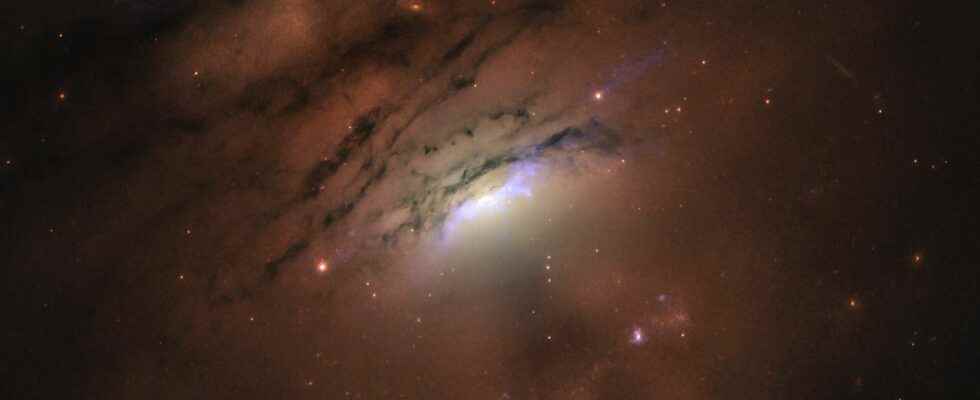You will also be interested
[EN VIDÉO] Closer to black holes Dive into the heart of black holes, these stars that devour all matter, and even light!
With several millions, even billions of masses solar, the supermassive black holes are located at the center of large galaxies. The Milky Wayour galaxy, is home to, for example, Sagittarius A*, whose very first image was recently unveiled! Although we do not yet understand how they form, we know how to study their influence on their environment. This is what an international team ofastronomers who was particularly interested in the jets of particles they emit when they accrete from the matter. Their results were published in the journal Nature Astronomy
Jets hitting the galactic disk
They targeted the galaxy IC 5063, located 156 millionlight years of the earth. Captured by the Hubble Space Telescope in 2019, its image is most curious: scientists describe alternating light and shadow areas, similar to twilight rays on earth. Everything seems to come from the nucleus of the galaxy, as if it were projecting light rays, which were either transmitted, therefore visible, or absorbed by the clouds molecular, therefore invisible. But this phenomenon remains unusual, because these light rays coming from the heart of the galaxy correspond in fact to jets emitted by the supermassive black hole which is there.
While the black hole inevitably attracts matter that comes too close to it, it deforms, falls towards it in a spiral. There then occurs what is called a accretion disk, made up of all this matter which gradually falls towards the horizon of the astronomical monster. The different strata of the accretion disk do not rotate at the same speed, so that because of friction, the gas heats up and ionizes. Electromagnetic radiation, or even jets of ionized material, are then emitted by the plasma of the disc, sometimes making it particularly luminous: in this case, we speak of quasar, for quasi-stellar. These jets are emitted perpendicular to the plane of the accretion disk, around which there is a torus of dust.
An artist’s impression explaining the unified AGN model. In any case, it is a supermassive black hole surrounded by an accretion disk, itself bordered by a huge torus of dust and gas. Jets of particles are emitted and, by observing an AGN parallel to one of these jets, a very luminous blazar is obtained. Perpendicularly, the perceived radiation is less intense and we mainly see a radio source. Between the two, and when the activity is very strong, it is a quasar. © NRAO Outreach
They could trigger star formation
Propelled at high speed in the galaxy, these jets exert an influence on the matter which they then cross. It is this influence that the team of researchers wanted to study, by targeting IC 5063. Because, in this case, the jets are emitted by the black hole in a different orientation from that usually encountered. Indeed, in general, these jets of supermassive black holes are emitted perpendicular to the galactic disk whereas, for the galaxy IC 5063, they propagate in the plane of the galactic disk and therefore directly affect the clouds of the interstellar medium. The alternation of dark and bright areas spans nearly 36,000 light-years, suggesting that the jet emitted by the central black hole’s accretion disk extended at least that far.
To learn more about these mysterious clouds that darken the galaxy, the team modeled several lines ofemissions through observations made by the VLT and Alma: that of carbon monoxide (CO), from cation formylium (HCO+), ionized sulfur and ionized nitrogen. This enabled them to calculate the densities and temperatures prevailing within the molecular clouds and the medium through which the jet passes, then to deduce the conditions of pressure.
“We performed several thousand astrochemical simulations to cover a wide range of possibilities that may exist in IC 5063”said Thomas Bisbas, co-author of the study and researcher at the University of Cologne. “In this way, we could obtain the optimal combination of parameters physical clouds at different places in the galaxy »added Georgios Filippos Paraschos, co-author of the study and doctoral student at the Institute Max Planck of radio astronomy in Bonn (Germany).
From these simulations, they were able to establish several pressure maps: that which reigns within the molecular clouds, and the pressure which surrounds them. However, when a sufficient density is reached in a molecular cloudit can end up contracting on itself and then become… a star ! “Our results show that supermassive black holes, even if located at the center of galaxies, could affect galaxy-scale star formation.said Professor Kalliopi M. Dasyra, first author of the study. Studying the impact of pressure changes on cloud stability was key to the success of this project. Once a few stars actually form in a wind galactic, it is usually very difficult to detect their signal above the signal of all the other stars in the galaxy harboring the wind. »
A desire to escape for the summer?
To celebrate the holidays as it should be, discover the Mag Futura at the preferential price of €15 instead of €19, i.e. a reduction of 20% !
On the program of this issue: a dive into the heart of 4 scientific themes that will mark 2022, from the Earth to the Moon:
- What mysteries does the Moon still hide from us?
- Will we soon be able to cure everything thanks to genes?
- How to feed the world without destroying it?
- Can artificial intelligence become truly intelligent?
What is Mag Futura?
- Our first paper journal of more than 200 pages to make science accessible to as many people as possible
- 4 major scientific questions for 2022, from the Earth to the Moon
- Home delivery*
*Delivery is made in France (excluding metropolitan France), Switzerland, Belgium.
Interested in what you just read?
